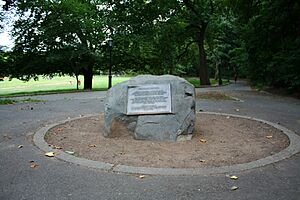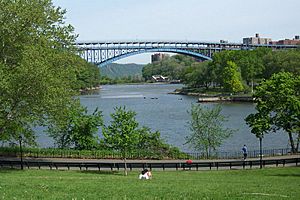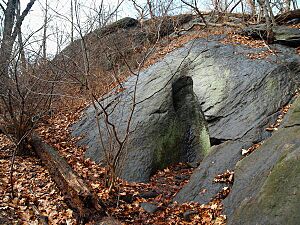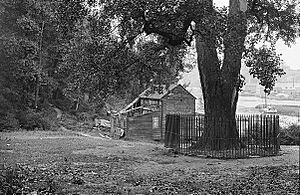Inwood Hill Park facts for kids
Quick facts for kids Inwood Hill Park |
|
|---|---|

Lenape caves
|
|
| Type | Urban park |
| Location | Inwood, Manhattan, New York City |
| Area | 196.4 acres (79.5 ha) |
| Created | 1926 |
| Operated by | New York City Department of Parks and Recreation |
Inwood Hill Park is a special public park in the Inwood neighborhood of Manhattan, New York City. It's managed by the New York City Department of Parks and Recreation. This park sits on a high ridge that rises about 200 feet (61 meters) above the Hudson River. It's known for having the largest remaining old-growth forest in Manhattan. This means it has very old trees that have grown naturally for a long time. Unlike many other parks in Manhattan, Inwood Hill Park is mostly natural, with lots of wooded hills and not much landscaping.
Contents
History of Inwood Hill Park
Ancient Times and Early Settlers
Inwood Hill Park has a long history, going back to before Christopher Columbus arrived in America. Native Americans called the Lenape lived here until the 1600s. They had a main camp along the park's eastern side. The Lenape used the Hudson and Harlem Rivers to find food. Scientists have found old tools and campfire remains in the park's rock shelters. This shows that the Lenape used these shelters for temporary homes.
A famous story says that in 1626, Peter Minuit bought Manhattan from a group of Native Americans right here in the park. He was the leader of New Netherland, a Dutch colony. The story says he bought it for goods worth 60 Dutch guilders (an old type of money). This deal supposedly happened under a giant tulip tree. That tree was huge and lived for centuries, but a storm knocked it down in 1933. Today, a large rock called Shorakkopoch Rock and a plaque mark the spot where the tree once stood.
Revolutionary War and Wealthy Estates
During the American Revolutionary War, a small fort called Fort Cockhill was built in the park. It was one of many forts the American army built in New York. This fort had two cannons and overlooked the water where Spuyten Duyvil Creek meets the Hudson River.
Later, in the 1800s, the area became home to country houses for rich families. One famous person who had a summer home here was Isidor Straus. He owned the Macy's department store and sadly died on the RMS Titanic. The owners of the Lord & Taylor department store also had two mansions in the park, but both burned down. There was even an orphanage on a high bluff in the park. Today, only a small paved area and benches remain where the orphanage once stood.
Becoming a Public Park
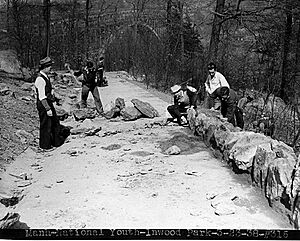
The idea for a park in Inwood first came up in 1895 from Andrew Haswell Green. He was in charge of the Central Park Commission. It took a while for his idea to catch on. But people eventually realized how special the area was because of its history, unique rocks, beautiful views, and archaeological finds. So, between 1915 and the early 1940s, New York City bought all the land that makes up the park today.
Inwood Hill Park officially opened on May 8, 1926. In the 1930s, people who were living in abandoned homes around the park were moved out. This was done by Robert Moses and the Works Progress Administration (WPA). The WPA was a government program that created jobs during the Great Depression. WPA workers also paved some trails and added lampposts, though many of these need fixing today.
On September 15, 1995, the Inwood Hill Nature Center opened. It's located near the park entrance at 218th Street and Indian Road. This center is on Manhattan's only saltwater marsh. It's a great place to learn about nature and watch the eagles that have been released in the park.
Geography of Inwood Hill Park
The park covers about 196 acres (79 hectares). The Henry Hudson Parkway and a train line run through it. At the park's northern end, the Henry Hudson Bridge and the Spuyten Duyvil Bridge connect Manhattan to the Bronx.
The Hudson River forms the park's western edge. Dyckman Street is its southern border. On the eastern side, the park is bordered by Payson Avenue, Seaman Avenue, and Indian Road. There are about 10 miles (16 kilometers) of footpaths that crisscross the park. These paths make it easy to reach Dyckman Street, Fort Tryon Park, and Fort Washington Park. Some of these trails were once roads leading to the old summer estates. Bolton Road, which was the main road to the Bolton estate, is now the main walking path in the park.
Inwood Hill Park has many different types of rocks, including marble, schist, and limestone. The park is also near the Dyckman Street Fault, which is a crack in the Earth's crust. This fault can cause small earthquakes. For example, in 1989, it caused a small earthquake.
Animals and Plants of Inwood Hill Park
The part of the park along the Harlem River has Muscota Marsh. This is one of Manhattan's last natural salt marshes. Salt marshes are wetlands where fresh and saltwater mix. They attract many water birds. You can learn more about these birds at the Nature Center.
Birds like mallards, Canada geese, and ring-billed gulls live here all year. Many other wading birds and waterfowl stop here during their spring and fall migrations. Herons and cormorants often spend the summer. In the salt marsh, you can also find fish, mollusks (like snails), and crustaceans (like crabs). These creatures live among plants like cordgrass and bulrushes, which can grow in both salty and fresh water.
The park's woods are home to many birds, like blue jays and cardinals. You might even spot wild turkeys! Birds of prey that live and raise their young here include red-tailed hawks and owls. From 2002 to 2009, there was a project to bring bald eagles back to Manhattan. Young eagles were brought to the park, and most of them learned to fly and live on their own.
Other animals in the park include small rodents like voles and deer mice. You might also see salamanders, southern flying squirrels, opossums, and cottontail rabbits. Of course, there are also many eastern grey squirrels and raccoons. Foxes used to live here, but they might have moved away because more coyotes are being seen in nearby parks.
What to Do in Inwood Hill Park
Inwood Hill Park has three children's playgrounds, baseball and soccer fields, and courts for tennis and basketball. The Inwood Hill Nature Center is a great place for educational programs. It's also where the Urban Park Rangers have their office. The park's ballfields are very popular and are used a lot by sports leagues from all over the city.
Because there isn't much green space in nearby areas, many people come to Inwood Hill Park for picnics and barbecues. While these activities are often not allowed in other city parks, Inwood Hill Park has special areas for them. This helps everyone enjoy the park's beautiful natural setting.
Images for kids
See also
 In Spanish: Parque de Inwood Hill para niños
In Spanish: Parque de Inwood Hill para niños


